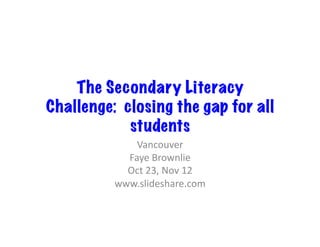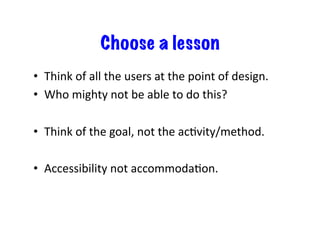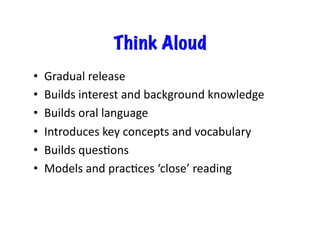Vsb sec lit #1
- 1. The Secondary Literacy Challenge: closing the gap for all students Vancouver Faye Brownlie Oct 23, Nov 12 www.slideshare.com
- 3. Frameworks It’s All about Thinking – Brownlie & Schnellert, 2009
- 4. Universal Design for Learning Mul>ple means: -‐to tap into background knowledge, to ac>vate prior knowledge, to increase engagement and mo>va>on -‐to acquire the informa>on and knowledge to process new ideas and informa>on -‐to express what they know. Rose & Meyer, 2002
- 5. Choose a lesson • Think of all the users at the point of design. • Who mighty not be able to do this? • Think of the goal, not the ac>vity/method. • Accessibility not accommoda>on.
- 6. Backwards Design • What important ideas and enduring understandings do you want the students to know? • What thinking strategies will students need to demonstrate these understandings? McTighe & Wiggins, 2001
- 7. Model Guided practice Independent practice Independent application Pearson & Gallagher (1983)
- 8. “Achievement Now” Alfred Tatum, DeKalb, Illinois • Kids could travel throughout the day and read less than 3 pages of text -‐ in a high achieving high school • Kids could go to the school and become smarter, but not become beWer readers
- 9. M – meaning Does this make sense? S – language structure Does this sound right? V – visual informa>on Does this look right?
- 10. • …the self-‐percep>ons of students as readers and their feelings about reading mediate the effec>veness of experimental interven>ons to improve achievement • Reed & Vaughn, 2010, cited in McGill-‐Franzen & Lubke
- 11. Think Aloud • • • • • • Gradual release Builds interest and background knowledge Builds oral language Introduces key concepts and vocabulary Builds ques>ons Models and prac>ces ‘close’ reading
- 12. 1975: Year of the Cat Today is Tet, the first day of the lunar calendar.
- 13. Every Tet we eat sugary lotus seeds and lu>nous rice cakes. We wear all new clothes, even underneath.
- 14. Mother warns how we act today foretells the whole year.
- 15. Everyone must smile No maWer how we feel. No one can sweep, for why sweep away hope? No one can splash water, for why splash away joy?
- 16. • Inside Out and Back Again – Thanhha Lai
- 17. Inquiry Circles • Choose your inquiry ques>on • Model how to ask ques>ons from an image, within the framework of the ques>on • Fishbowl an inquiry circle conversa>on • Other student observe for ‘what works’ • Build criteria for effec>ve group behaviour
- 18. Vocabulary/terms Images Ques3ons Key ideas
- 19. The 10 Greatest Canadian Environmentalists – Discovery Series, Scholas>c
- 23. Inquiry Circles • Select 4-‐5 different ar>cles, focused on central topic or theme. • Present ar>cles and have students choose the one they wish to read. • Present note-‐taking page. • Student fill in all boxes EXCEPT ‘key ideas’ before mee>ng in the group. • Students meet in ‘like’ groups and discuss their ar>cle, deciding together on ‘key ideas’. • Students meet in non-‐alike groups and present their informa>on from their ar>cle.






















